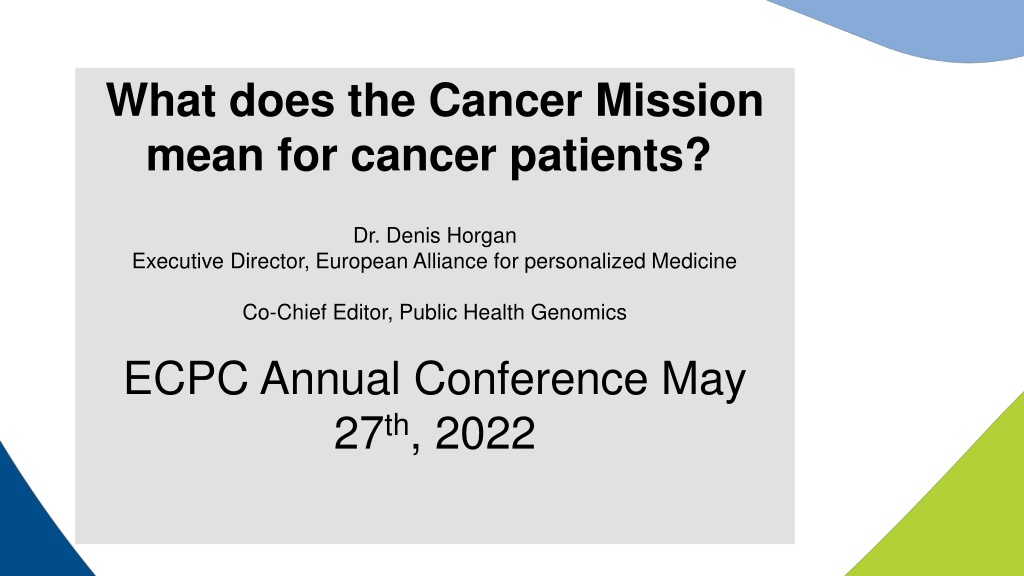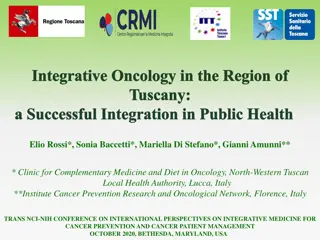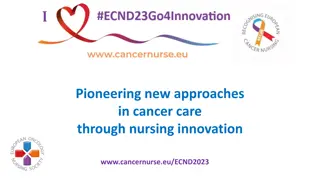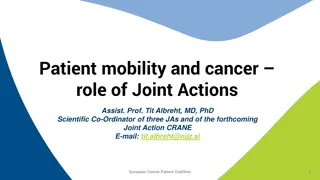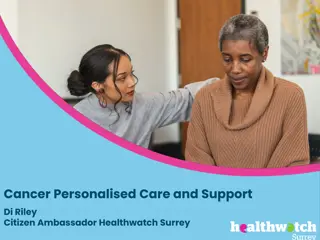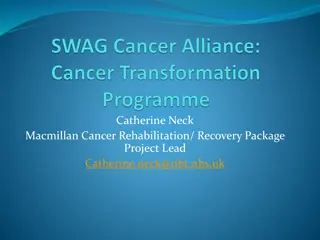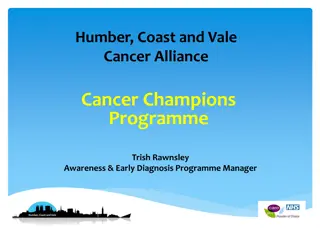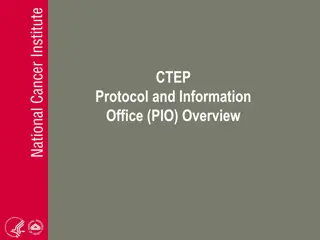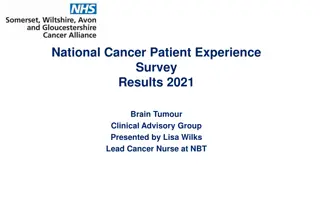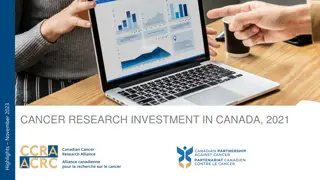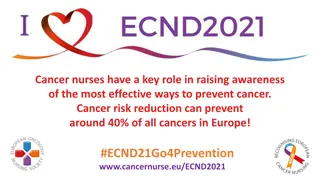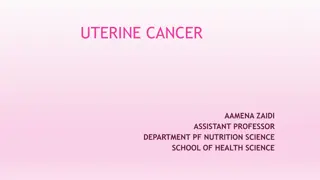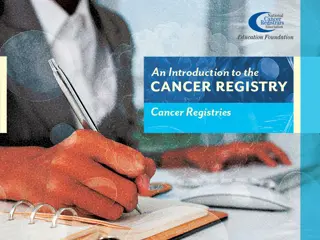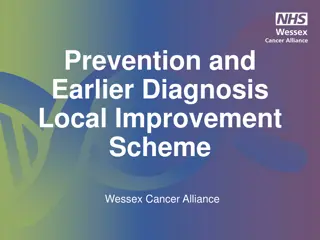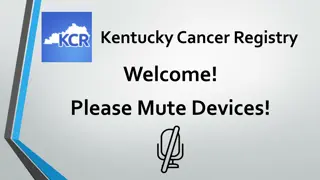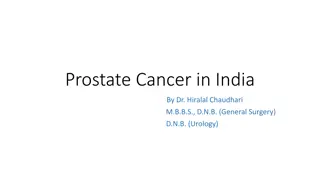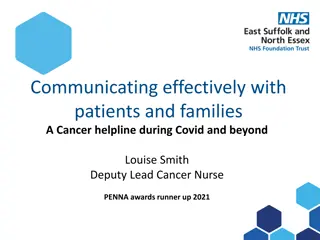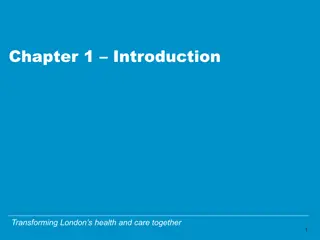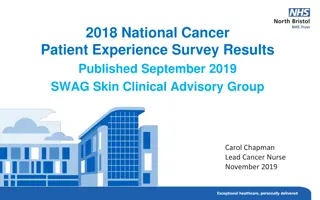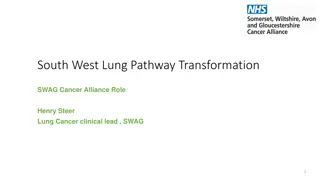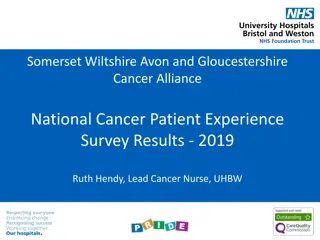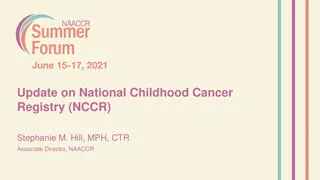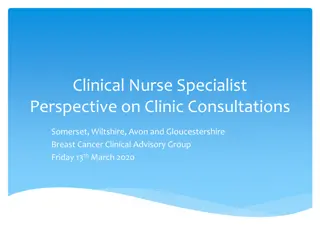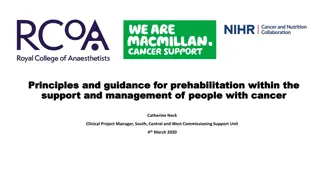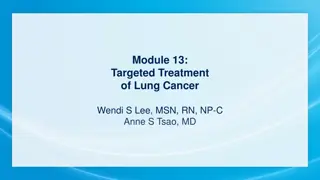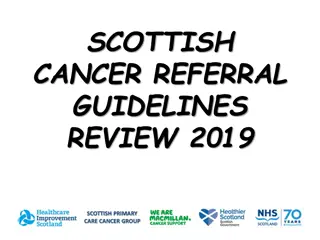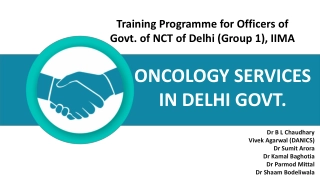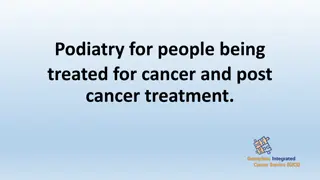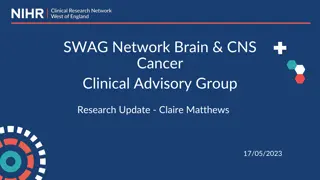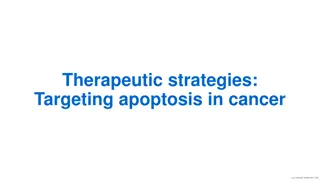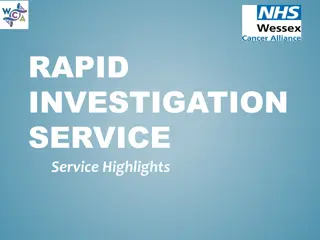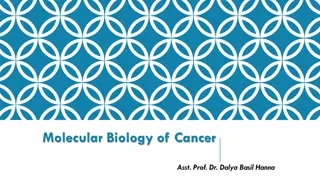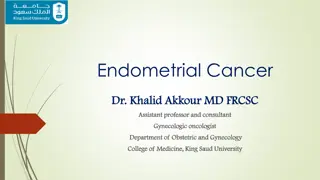The Future of Cancer Care: Embracing Personalized Medicine
The cancer mission aims to revolutionize patient care through personalized medicine, tailoring treatment strategies based on individual characteristics. Dr. Denis Horgan emphasizes the need for patient-centered care and the challenges in implementing innovative healthcare solutions efficiently within traditional institutional processes. Key elements include the role of public servants in policy-making, the importance of clear vision and strategy, and the necessity of policies to translate strategies into effective health services.
Download Presentation

Please find below an Image/Link to download the presentation.
The content on the website is provided AS IS for your information and personal use only. It may not be sold, licensed, or shared on other websites without obtaining consent from the author. Download presentation by click this link. If you encounter any issues during the download, it is possible that the publisher has removed the file from their server.
E N D
Presentation Transcript
What does the Cancer Mission mean for cancer patients? Dr. Denis Horgan Executive Director, European Alliance for personalized Medicine Co-Chief Editor, Public Health Genomics ECPC Annual Conference May 27th, 2022
Nomen est omen No commonly agreed definition of the term personalised medicine . Widely understood that personalised medicine refers to a: medical model usingcharacterisation of individuals' phenotypes and genotypes (e.g. molecular profiling, medicalimaging, lifestyle data) for tailoring the right therapeutic strategy for the right person at theright time, and/or to determine the predisposition to disease and/or to deliver timely and targeted prevention. Personalised medicine relates to the broader concept of patient-centred care, which takes into account that, in general, healthcare systems need to better respond topatient needs
1. Public servants get to make recommendation and provide advice to politicians but it is the politicians that make decisions. 2. After politicians made decisions (sometimes but not always base on such advice), public servants have to develop strategies and policies to implement these decisions. 3. Too often, advice, strategies and policies take too long, are confusing and lack coherence and integration. 4. Major health care reforms and changes follow this legacy linear institutional process. 5. Adoption of exponential advances in science, technology and knowledge in healthcare are currently frustrated by a legacy linear institutional process 6. The scene is set for a complex collision of rising consumer demands for better precise and personalized health services and the glacial adoption of exponential advances . . 4
Even the best innovative solutions will not become the new business as usual, if political, public service, professional and private sector leaders are unclear about their purpose, vision, mission, strategy, and policies PURPOSE VISION MISSION STRATEGY POLICIES 5
1. Strategy is about priorities and choices. 2. Policiesare necessary rail-guards for the translation of strategy into eventual health services. 6
Key policy anchors: 1. Health service - What new health services will be provided? 2. Providers - who, where and when these services will be provided? 3. Eligibility & coverage who, where, when and for how long can these new services be access? 4. Funding - how will these services be funded and who will pay for these services? 7
Even when there is clarity and cohesion of strategy and policy, implementing new services still require the right enablers and appropriate business models 8
PERSONALISED CANCER TREATMENT: Key questions for politicians, policy makers, professionals and private entrepreneurs 1. Is there a clear and coherent strategy for personalised medicine? And if so, what part does it play in any existing national cancer strategy? 2. If, there is such a strategy, has the public service developed appropriate enabling policies on the for 4 key policy anchors? 3. If such enabling policies are in place, how does it inform and guide funding decisions, investments in new services and enablers such as workforce, technology, facilities and devices? 4. Is the current organisation and business model fit for purpose? 5. What are the top three barriers standing in the way? 9
Conquering cancer: mission possible Mission Outline 22 September 2020 Goal: By 2030, more than 3 million lives saved, living longer and better Five intervention areas: 1. understanding 2. prevention 3. diagnosis and treatment 4. quality of life 5. equitable access 13 recommendations for bold actions https://op.europa.eu/en/web/eu-law-and-publications/publication- detail/-/publication/d0235612-b68a-11ea-bb7a-01aa75ed71a1
OECD, Nov, 2021 : 16 percent increase in the number of deaths above expected levels in 2020 and the first half of 2021 life expectancy fell in 24 of the group s 30 member states. 1 in 3 people will get cancer .
EBCP states the established opinion for a set of actions: Plan an attempt to address this and set a framework forward Plan are not followed Implementation and follow up is often ignored Local implementation most influential Inclusion of payers and stakeholders will improve implementation in particular the patients: Links to resource allocation Development of registries to assess implementation Increase use of biomarker testing
Molecular Diagnostics for NSCLC CECOG Survey, 2017 Country EGFR ALK Test Reimburs. Test Reimburs. Test ROS1 Reimburs. BRAF Reimburs. PD-L1 Reimburs. Test Test Austria Bulgaria Full, PHS Pharma Full, PHS Pharma Full, PHS No, but available No, but available Full, PHS NA Full, PHS Pharma No If requested Croatia Partly PHS/ Pharma Partly PHS/ Pharma NST If requested No Partly PHS/ Pharma Czech Republic PHS (limited budget) PHS (limited budget) No, but available No NA If requested No Hungary PHS (limited budget) PHS (limited budget) PHS (limited budget) PHS (limited budget) If requested PHS (limited budget) Poland PHS (limited budget) PHS (limited budget) No, but available If requested Pharma Romania Pharma Pharma No, but available No, but available PHS (limited budget) If requested No Serbia Pharma NST No NST Within CTs NA Slovakia PHS (limited budget) PHS (limited budget) No NA If requested PHS (limited budget) Slovenia Full, PHS Full, PHS No, but available No Pharma PHS-Public Health System; Pharma-Pharmaceutical Companies; NST-No Systemic Testing; NA- not applicable; CTs- clinical trials. Ryska A, et al. BMC 2018; Ryska A, et al. Oncologist 2018.
Access to Novel Drugs for NSCLC CECOG Survey, 2018 Registered and available for majority of patients through governmental/private insurance Registered and available for a minority of patients with special insurance/other Registered but not available/reimbursed Not yet registered a refers to use of crizotinib in ALK+; b refers to crizotinib in ROS1+ in first- or second-line. Cufer T, et al. Oncologist 2020.
Health policy guidelines Provide guidance for decisions for groups of patients Provide guidance for priorities and resource allocation Academic practice guidelines Provide guidance for clinical decisions for individual patients Summarise clinical evidence and clinical experience
Who Decides on Value? 19th Century Medicine Doctors and patients Price discrimination common practice 20th Century Medicine Regulators (safety and efficacy) Doctors and patients 21st Century Medicine Third party payers (public and private) Regulators (Safety, efficacy and relative effectiveness) Doctors and patients
Gaps Current lack of trained people looking beyond single fields We do not have any data production structure so that today genetic sequencing leading to a clinical decision is restricted to cancer and liver-toxicity. A fruitful cooperation between stakeholders needs to be fostered. We should inform them, imply them in options as well as choices. A policy gap: laws and regulations by EU and national governments focus on data protection. One has to move away from protection and privacy towards control of one s own data and thus true empowerment of the citizen. The legal part of PM might be easier when working cross borders. Maybe by the EC. Lack of companion diagnostics for many treatments The biggest gap lies in sharing of the interpretation and knowledge. There is currently more effort on data sharing, but not yet on interpretation, knowledge management and knowledge sharing across private/public boundaries.
Needs Better links between funding bodies, industry and the technology platforms Decrease the complexity and access barrier to technology for normal general hospitals. This is not only about the technology but also about decision support systems from data. To set up multidisciplinary teams with basic researchers and clinicians to work together in the implementation of biomarkers in the field. Partnership between several stakeholders. Data providers and technology manufacturers agreement. Public and private engagement. Long term funding for critical resources and infrastructures. A smart implementation strategy is needed. New ways of innovation in health care systems. Decision making to tackle the connection between genomic and clinical worlds .
Personalised Medicines: a tool towards a sustainable health care? Lithuania 8,421 Portugal 9,002 Primary Outpatient A&E Inpatient Medicine Hungary 9,177 Sweden 9,325 Bulgaria 9,600 Denmark 9,891 Cyprus 10,081 Romania 11,140 Latvia 11,314 Belgium 11,410 Slovenia 12,215 Italy 12,526 Malta 13,642 France 14,459 Spain 14,623 United Kingdom 15,955 EU-27 16,243 Slovakia 16,478 Czech Republic 17,175 Ireland 18,072 Estonia 21,036 Netherlands 21,301 Poland 21,475 Germany 22,887 Austria 23,476 Luxembourg 24,381 Finland 24,646 Greece 26,215 0 5,000 10,000 15,000 20,000 25,000 30,000 35,000 40,000 Healthcare costs per incident COLORECTAL cancer, adjusted for price diferentials
EU Screening Score: First Movers and others moved by EU 2020 2010 2000 1990 1980 1970 1960 1950 Portugal Italy Germany Norway Hungary Greece Sweden Finland Spain Czech Republic Serbia Latvia Lithuania Bulgaria Croatia Romania Belgium
Is it because we do not know how to implement such a program in a cost-effective way? Which persons should be invited? Cost-effective risk groups Which persons will show up? Equity aspects What are the optimal screening intervals? How do we control quality and outcome of the interventions?
Are there better alternative uses for resources? Policies to reduce smoking Have benefits in terms of reduction of other diseases as well New innovative treatments for lung cancer High medical need for patients with established disease
State of Lung Cancer: Survival rate details All countries show an upward trend Sweden and Norway have steepest increases in survival Compared with most other cancers, survival rates remain frustratingly low Romania s survival rates lower than other countries, but follows positive trend Austria continually had highest five-year survival results In 2010-14, five-year survival rate was 19.7%
Integrating Biomarkers into cancer care
Molecular Diagnostics of Cancer Challenges There is no established decision making procedure/ policy on the reimbursement of biomarker testing by the public health system/insurance; at introduction molecular tests are mainly covered by pharma. Access to multiple-gene panel NGS testing is limited and does not ensure equal access; especially not for the patients treated outside large cancer centers. Molecular tumor board (MTB) is established only at the comprehensive cancer center. There is no formal engagement of other centers. There is a lack of bioinformaticians and molecular geneticists. Access to novel drugs is limited due to lack of clinical trials and due to long lasting national drug reimbursement procedures.
Need for Action - Rational Allocation of Resources in Society Constrained resources and increasing demand for health care Costs from investing in different areas of cancer care need to be weighed against potential improvements in patient outcomes Use of scarce resources in a cost-effective and efficient way to ensure value-for-money for patients and taxpayers
Implementation cooperation, resources Cooperation Cancer Plan, Horizon Europe, other EU policy Member States - regions, cities Foundations Civil society Industry Etc. Resources Funding from Horizon Europe for R&I actions Deployment through other MFF instruments National/regional financial support De-risking private investments Etc.
What does the Cancer Mission mean for cancer patients? An Oppurtunity A Challenge Nothing About Us Without Us 31 European Cancer Patient Coalition
Dr. Denis Horgan, PhD, LLM, MSc, BCL EAPM Executive Director, Chief Editor, Public Health Genomics THANK YOU EAPM, Avenue de l'Armee/ Legerlaan 10, 1040 Brussels, Belgium Ph: + 386 30 607 281 Website: www.euapm.eu 32 European Cancer Patient Coalition
